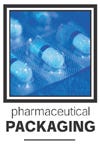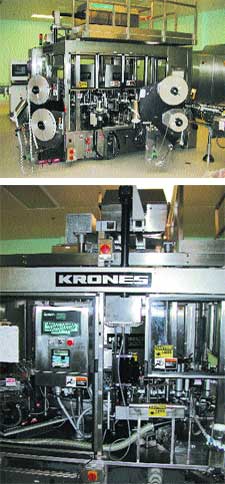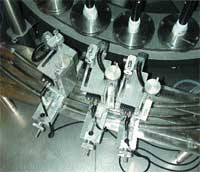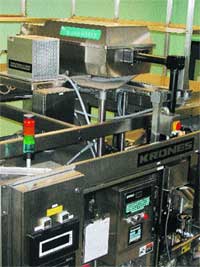Providing all of the required information on prescription bottles is a challenge for pharmaceutical companies because of space limitations. Procter & Gamble found itself with a challenge with

its osteoporosis drug Actonel 5-mg daily dose: It wanted a label on the front of its patented oval-shaped Safety-SquEase bottle that would provide information for the patient, and a label on the back with information for the pharmacist. The front label had to be of prime label quality, and it had to be resealable for future and continued use by the patient. The back Extended-Text® (ET) label, which provided information not intended for the end-user, had to be easily removable from the bottle by the pharmacist before the bottle was dispensed. The Safety-SquEase bottle, first used for Aleve, won the 1994 Package of the Year award and received the CPSC Chairman's Commendation for significant contribution to product safety. Using an oval bottle was perceived as a packaging challenge.
To address this, P&G began working with Inprint USA, which has a
|
Rotary labeler, top photo, incorporates primary and secondary unwind systems for front and back labels. A laser, bottom photo, prints the lot number and expiration date of the product on the front label of each bottle. |
long history of pharmaceutical industry involvement. "We entered the P&G project when some of the development work had already been done by the engineers," says Inprint CEO David Barry. "The requirement was to provide both patient and pharmacist leaflets on the uniquely shaped bottle. Our initial approach was to create a brand new label design, which incorporated two separate leaflets within one label that wrapped around three sides of the bottle. The advantage of such a design was, of course, that it left only one gap on the bottle, and it had only one closure, thereby maximizing the available label/leaflet area."
However, all of this changed when the design was revised to separate front and back labels. The design parameters for the two labels were distinctly different. The front label was for the patient, and its look needed to reflect the quality of the product. It also needed to be easy to open and reseal, and it had to provide sufficient graphic and text area in such a format that the necessary text could be included at a large enough point size for the target users, who tend to be older.
At the same time, as the primary label, and the one that would stay with the bottle through its life, this label had to carry the lot and date overprint. Laser coding had been selected, but extensive testing indicated that, while coding through a plastic overlaminate was possible, the results were not as readable as coding directly onto a patch of dark ink.
To meet all these requirements, Inprint designed a double-folded, partially laminated Incirc™ label. Incirc is Inprint's trade name for an ET label that can be opened like a book and then resealed by the end user, according to Inprint marketing and technical consultant Jim Yonge.
The double-folded booklet for Actonel provided pages that were twice the width of the leaflet area on the label, thereby allowing long enough lines of copy so that, even at a large type size, a reasonable number of words would fit on each line. The partial laminate provided the protection and "quality look" for the front of the leaflet and the closure, and resealability to the bottle. The absence of laminate over the leading portion of the label allowed for a laser-codable, open patch of color, as well as sufficient flexibility to allow for bidirectional wiping down of the label.
The front label is a 23/16 x 29/16-in., 48-page folded booklet, printed on two sides and covered with a clear overlaminate. This front ET label also had to be printed with a lot and date code. The method decided on was to use a laser printer that would fire a code into a solid blue color box. The blue ink is burned off, creating a white code due to the base white stock used on the ET label. The code had to be readable by a vision system, so the laminate used on the front to open and close the label could not overlay the code box area.
Large amount of text on back label
For the back label, the key issue was how to get the very large amount of text that was needed into the small area available for the label in such a way that it could be machine-applied reliably at a high speed. Easy opening and removability from the bottle by the pharmacist prior to application of the pharmacy label were also required. The amount of text dictated the use of a folded leaflet rather than a booklet. Simple mathematics on the amount of text and the area available for the leaflet showed that the leaflet would have to be very long and folded many times. The multiple thicknesses in the final folded piece argued for the use of the thinnest material consistent with acceptable showthrough and print quality.
|
Cameras determine presence of labels and check for lot number and expiration date. |
To economically print such material to produce the leaflet length needed, Inprint developed another new label construction: this time an Incirc with a "double-length leaflet." The 5 x 3/4-in. back label has a footprint size of 23/16 x 21/2 in. The leaflet is two-ply accordion- or concertina-folded.
This label, while inevitably very thick, is sufficiently flexible to be applied at a high speed. A deadened corner on the laminate sealing flap allows for easy opening, and the leaflet can be quickly removed in its entirety. Despite the label's extreme length, the design still allows for future additional text requirements without needing any redesign of the package or application line.
"Inprint has done an excellent job for us. They're technically excellent and very quality-conscious," says OSG packaging manager Dave Brown. "They really showed up to provide a labeling solution. Any time I need a custom label, I'll definitely call them."
Unique label-splicing technology
In '01, P&G Pharmaceutical Div. sold the Norwich plant to a group that included plant employees. The new company, Outsourcing Services Group (OSG), continues to run Actonel for P&G, as well as a number of other products.
Both front and back labels are supplied on rolls and utilize a splicing system from Germany called LabelLink®. The system was introduced by North American distributor J.P. Hamel Packaging, Inc.; Inprint is the distributor for the U.S. and Puerto Rico. LabelLink is a multilayered splicing tape designed to produce nearly uninterrupted labeling on low- and high-speed labeling lines.
In the past, the operator would have to stop the line, cut the liner down, then cut a piece of splice tape from a roll and attach the new roll of labels. The operator then had to wait and hope the splice cleared the peel plate, which could take as long two to five minutes. And, if the splice failed, the downtime was doubled or more.
With LabelLink technology, the splice takes about seven seconds, and splice-breaks at the peel plate are eliminated. The operator at OSG changes a roll about every seven minutes, so the benefit is obvious. The predictability of a successful link is as valuable to the operation as the minimum downtime itself, and it helps eliminate stress when changing the rolls.
|
Pulsed carbon dioxide laser is mounted on top of the labeler. |
The LabelLink system consists of a unique two-layer adhesive tape that Inprint uses to attach the roll of its labels to the paperboard core. When the end of the roll is reached, the two layers of LabelLink separate, and a release layer remains on the core. The second layer stays on the reverse side of the release liner of the roll of labels. The operator removes the old core and places a new roll of labels on the unwind platter. He then removes a couple of labels from the new roll to expose the release liner. The exposed adhesive surface of the LabelLink tape on the back of the old roll is covered with a special adhesive coating. The operator sticks the end of the old roll to the exposed silicone liner on the new roll, making sure that the spacing between labels is maintained.
"LabelLink is a great development. It cut our label-splicing time to practically nothing and just about eliminated label breaks," says Brown. "With all of the roll changes we do, LabelLink has improved efficiency tremendously."
Rotary labeler applies front and back labels
As part of this project, P&G installed a complete new packaging line, including a Krones Autocol rotary labeler to apply the pressure-sensitive labels. The machine incorporates primary and secondary unwind systems for both front and back labels, which are applied to the bottles on opposite sides of the machine. The machine also includes an outsert applicator, which is not required for the Actonel bottle, but is used for other bottles run on the line.
When a primary roll is getting close to running out of labels, an electronic low-label detector mounted on the unwind unit notifies the operator through a four-color light-array column, so he is ready to switch rolls as described above. It is far simpler to connect the new roll of labels to the one in the machine than it is to re-thread the labels, so if the operator does not respond within a preset time, the machine stops automatically. In addition, a sensor at the label station stops the machine if it detects a broken web, a bad splice or other problems.
The labels are pulled into the machine, pass over a series of rollers and are then stripped off of the backing and applied to the bottles. The backing travels out of the machine to a pickup roll. The roll of labels is pulled through the machine by the backing pickup roll, but the rollers at the infeed are controlled to apply varying levels of back-pressure to maintain the proper tension on the web.
The oval bottles are oriented on the conveyor ahead of the machine and then enter a feedscrew that delivers them into an infeed starwheel. This meters each bottle onto a plate on the machine that turns as the machine rotates to orient the bottle during the entire labeling operation. The machine has 25 of these bottle plates. A sensor detects the presence of the bottle at the first labeling station and tells the machine to apply the label, which, in this case, is the back label of the bottle. The rotating machine carries the bottle past wipers that firmly affix it to the bottle. As the machine continues to rotate, the bottle table is spun 180 deg so that the front label will be exactly opposite the back label. Again, a sensor triggers label application, and wipers affix the label after it has been applied.
A Blazer® 6000CE pulsed carbon dioxide laser from Lasertechnics mounted at the second labeling station prints the lot number and expiration date of the product on the front label of each bottle.
The bottles exit the Autocol through a starwheel, where two opposed cameras determine the presence of the front and back labels by seeing the ultraviolet printing on the labels. Two other video cameras check the lot number and expiration date. The cameras capture an image of the character string to be verified, which is then processed using specialized optical character verification (OCV) algorithms that compare the read characters to a set of characters previously taught to the system by the user. Input from the cameras is processed by a PC-based MVS-8110 vision system from Cognex Corp.
Other equipment in this new packaging line includes an Omega Design bottle sorter, a DT Merrill tablet slat filler, a DT Lakso cottoner, a Lepel Corp. induction sealer, an IMA North America, Inc. case packer, and a PRB Packaging Systems palletizer.
More information is available:
Labels, splicer: Inprint USA, 888/385-2235. Circle No. 232.
LabelLink distributor: J.P. Hamel Packaging, Inc., 613/741-3795. Circle No. 233.
Printer: Lasertechnics, 515/822-1123. Circle No. 234.
Vision system: Cognex Corp., 508/650-3000. Circle No. 235.
Bottle sorter: Omega Design Corp., 610/363-6555. Circle No. 236.
Tablet filler: DT Merrill, 847/647-5901. Circle No. 237.
Cottoner: DT Lakso, 978/537-8534. Circle No. 238.
Induction sealer: Lepel Corp., 262/782-0450. Circle No. 239.
Case packer: IMA North America, Inc., 203/255-3900. Circle No. 240.
Palletizer: PRB Packaging Systems S.r.L. , 39-051-945892. Circle No. 241.
About the Author(s)
You May Also Like





